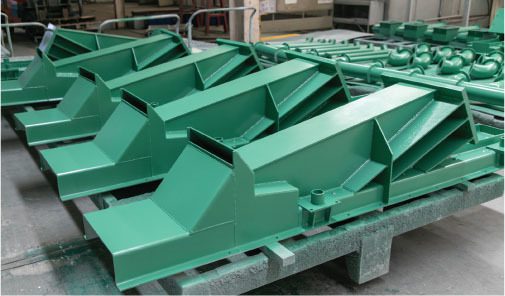By Cynthia A. Gosselin, Ph.D., The ChemQuest Group
The idea of ASTM standards written for market specificity was introduced in the ASTM article from the January-February 2025 issue of CoatingsTech that discussed the requirements for coil coated building panels. Another example falls under the authority of ASTM Committee A05. Two specifications are written precisely for the sheet metal framing industry. Studs, purlins, joists, girts, and tracks are examples of these products that must conform to detailed strength, coating, and corrosion parameters to ensure the integrity of buildings.
The first one is ASTM A1003/A1003M Standard Specification for Steel Sheet, Carbon, Metallic- and Non-metallic Coated Cold-Formed Framing Members. This standard governs the steel grades, strength levels, metallic and nonmetallic coating requirements, testing reporting information, and ordering parameters for the entire industry. Steel producers, coil coaters that apply inorganic and organic topcoats (prepainted) and roll formers (post-painted) are the main targets of this standard. Customers are assured through the ordering and testing processes outlined in this standard that the products conform to all requirements across the steel-coating spectrum.
The adjunct to ASTM A1003/1003M is ASTM A1004/A1004M Standard Practice for Establishing Conformance to the Minimum Expected Corrosion Characteristics of Metallic, Painted-Metallic and Nonmetallic-Coated Steel Sheet Intended for Use as Cold-Formed Framing Members. This practice details the laboratory procedures used for assessing corrosion performance to verify that coated materials listed in A1003/A1003M satisfy the minimum corrosion requirements. This standard is normally used to verify that potential new material additions to A1003/A1003M meet the minimum requirements. However, the testing parameters within A1004/A1004M have also proven useful for settling claim disputes, verifying coating compliance of commercial materials, and ensuring that the metallic (steel mills) and nonmetallic coating operations (coil coaters and roll formers) remain in compliance with base metal, coating weight, and film thickness requirements that ultimately govern product durability in the field. Ordering requirements assist users in obtaining the material tailored to their needs.
These two ASTM documents are germane to AISI S903-13 Cold-Formed Design Manual—Standard Methods for Determination of Uniform and Local Ductility. Any changes to the ASTM standards are scrutinized by the Iron and Steel Institute Committee to ensure compatibility with industry building and inspection codes.
ASTM A1003/1003M updated in 2023 via the 5-year review process incorporated new base metal or coating materials that qualified for commercial use. The standard contains material details from base metal to topcoat requirements. Included are product analyses of steel heats used in the manufacture of the base metal, sheet thickness, and mechanical property requirements for the various structural, nonstructural, high, or low ductility steels. Metallic coating chemistry and weight [mass] for each product iteration are also identified. Paint (topcoat) chemistries, film thickness, flexibility, adhesion, and corrosion requirements are called out for both prepainted and post roll-formed parts to ensure durability. Each coil is required to have a ticket with a test report verifying all the physical and material properties of the base metal, metallic, and nonmetallic coatings as desired by the end customer.
In A1004/A1004M, the practice involves exposing flat and formed samples of metallic coated, painted metallic coated, or painted nonmetallic coated sheet steel to salt spray testing according to ASTM B117 Standard Practice for Operating Salt Spray (Fog) Apparatus.
Each type of material must meet the minimum corrosion resistance requirements for the specific substrate/metallic/nonmetallic coating combination after testing for 100–500 hours of salt spray. Generally, metallic coated fully painted samples are exposed for at least 500 hours, while those coated with nonmetallic thin films are closer to the 100-hour range.
Tested panels are evaluated according to ASTM D1654 Standard Test Method for Evaluation of Painted or Coated Specimens Subjected to Corrosive Environments Procedures A (scribed), B (unscribed), and D (formed). Scribed panels can incorporate a 40° diagonal or X-scribe depending upon the agreement between the producer and user. Photographic standards provided in D714 Standard Test Method for Evaluating Degree of Blistering of Paints are used in the evaluation of unscribed panels. Formed panels are evaluated in bends, dimples, or other areas of interest for blistering and/or delamination from scribe as agreed upon by the producer and user.
These two product standards draw heavily upon a variety of individual technical ASTM Committee A05 and D01 standards governing everything from base metal chemistry, metallic coating thicknesses and chemistries, organic topcoat characteristics, and testing parameters that ensure every producer has a blueprint for supplying the exact material required by the building industry. This blending of committee standards allows for material uniformity across the industry that can be confidently verified as AISI building codes evolve.
Cynthia A. Gosselin, Ph.D., is director at The ChemQuest Group, www.chemquest.com. Email: cgosselin@chemquest.com.
